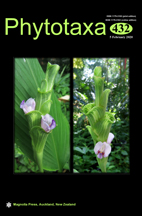Abstract
While revising the genus Dillenia Linnaeus (1753: 535) for Malaysia, Hoogland (1952) proposed the new combination, Dillenia mansonii (Gage 1906: 73) Hoogland (1952: 83) by transferring Wormia mansoni Gage (1906: 73) (Wormia mansonii). Gage (1906) in the protologue of W. mansonii cited the specimen examined as ‘In ripis fluminis Yunzalin, prope confluentum cum Salween, Tenasserim. Manson!’. Hoogland (1952) cited ‘Type specimen: Manson, banks of Yunzalin, Riv. above its junction with the Salween, Burma, May 1905; holotype in CAL’ under D. mansonii. During the study, we could trace out four such specimens housed at CAL (CAL0000004061, CAL0000004062, CAL0000004063 and CAL0000004064), three of which are annotated by Hoogland as ‘type’ (CAL0000004061, CAL0000004063, CAL0000004064) and the remaining one as ‘ISOTYPE’. However, in our opinion, these specimens are to be considered as syntypes following Art. 40, Note 1 (McNeill 2014, Turland et al. 2018). The citation of ‘Holotype’ by Hoogland has to be accepted as a correctable error under Art. 9.10 (Turland et al. 2018). There are more than one specimens at CAL of a single gathering and it cannot be ascertained which specimen Hoogland (1952) designated as the holotype. Hence, the holotype designated by Hoogland (1952) should be corrected to first-step lectotype (Art. 9.17: Turland et al. 2018). We have designated here a second-step lectotype following the Art. 9.17 (Turland et al. 2018).

